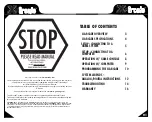
Technical Bulletin—TC-9100 Universal Controller
5
Note 1: Digital inputs 1 and 2 may be used with any sensor that
provides a dry (voltage-free) and isolated contact, suitable for
low-voltage (24 V) switching. Digital Input 1 may also be used
with the Johnson Controls Condensation Sensor, code number
HX-9100-8001. No other condensation sensor may be used
except a sensor which provides a dry contact that is isolated
from all other electrical circuits.
Note 2:
The TC-9100 controller is compatible with the
RS-1100
series
of room modules for room temperature, remote set point and
temporary occupancy mode change inputs. The controller is
also compatible with the TM-9180 Room Command Module,
which also provides 3-speed fan override and operating mode
override.
Only one
RS-1150/RS1160 series
module with an
occupancy mode button or only one TM-9180 may be
connected to the controller.
The TC-9100 Universal Controller can operate in any of the following
modes:
•
Standalone mode
•
Alternate mode
•
Supervisory mode
•
Low Limit (Anti-freeze) mode
•
Summer/Winter Compensation mode
•
Auto-dial mode
When the TC-9100 Universal Controller is
not
connected to a supervisory
system via the communications bus,
nor
to a TM-9180 Room Command
Module with LCD display, it will operate in one of three operating
modes, which are indicated on the
RS-1150/RS-1160
Room Command
Module, as follows:
•
COMFORT (room occupied):
LED on steady
•
STANDBY (room unoccupied): LED flashing
•
OFF (room not in use):
LED off
The Operating mode is determined by the status of the digital inputs when
configured as Window Contact or Occupancy Sensor, and may be
modified by the occupancy button on the
RS-1100
series Room
Command Module as shown in Table 2. When not assigned to a digital
input, the Window Contact function is assumed to be Window Closed,
and the Occupancy Sensor function is assumed to be Occupied.
Modes of
Operation
Standalone
Mode






































